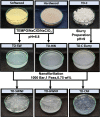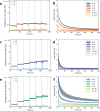Preparation and Characterization of Softwood and Hardwood Nanofibril Hydrogels: Toward Wound Dressing Applications
- PMID: 37950687
- PMCID: PMC10716857
- DOI: 10.1021/acs.biomac.3c00596
Preparation and Characterization of Softwood and Hardwood Nanofibril Hydrogels: Toward Wound Dressing Applications
Abstract
Hydrogels of cellulose nanofibrils (CNFs) are promising wound dressing candidates due to their biocompatibility, high water absorption, and transparency. Herein, two different commercially available wood species, softwood and hardwood, were subjected to TEMPO-mediated oxidation to proceed with delignification and oxidation in a one-pot process, and thereafter, nanofibrils were isolated using a high-pressure microfluidizer. Furthermore, transparent nanofibril hydrogel networks were prepared by vacuum filtration. Nanofibril properties and network performance correlated with oxidation were investigated and compared with commercially available TEMPO-oxidized pulp nanofibrils and their networks. Softwood nanofibril hydrogel networks exhibited the best mechanical properties, and in vitro toxicological risk assessment showed no detrimental effect for any of the studied hydrogels on human fibroblast or keratinocyte cells. This study demonstrates a straightforward processing route for direct oxidation of different wood species to obtain nanofibril hydrogels for potential use as wound dressings, with softwood having the most potential.
Conflict of interest statement
The authors declare no competing financial interest.
Figures












